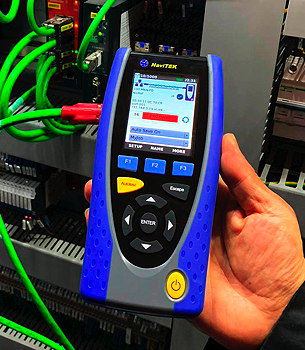- Home » News » Product News
Industrial Ethernet network and cable tester is ‘the first’

Ideal Networks has launched what it claims is the first purpose-built, handheld network tester for commissioning, maintaining and troubleshooting Profinet and standard Ethernet IP networks, using either copper of fibre optics. The rugged NaviTek IE troubleshooter simplifies testing of both cabling and networks that use the Profinet protocol. Ideal says that, previously, a laptop with specialist software has been needed to identify and test network nodes and for configuration.
The touchscreen tester includes tools specific to the needs of Industrial Ethernet, where packet delivery time is critical. It can help to pinpoint potential issues before a network fails. A “traffic light” health check provides a quick indication of how each device is performing. Clicking on the device provides further details of any issues, allowing corrective actions to be taken.
Wiremap tools allow users to discover cable, network or device configuration faults, at the touch of a button. The tester uses Time Domain Reflectometry (TDR) to provide accurate distances to faults, testing every wire in a data cable, not just pairs, to help isolate issues that other testers cannot detect.
For copper cabling, the tester displays the correct wiring colours for the protocol used, measures cable lengths, and determines where and what the cable fault is, including split pairs, open-circuits, short-circuits and mis-wires. An optional SFP module can be used to test fibre cabling at different wavelengths, to measure the optical power being received, and to discover faults such as dirty connectors, breaks or excessive bends.

The tester can also discover incorrect device names, duplicate IP addresses, network latency issues and packet losses, and can display and validate network node details. An event logger helps to find intermittent issues by recording all of the network errors in a 48-hour period to determine whether the issue lies with the cabling, node, PLC or network configuration.
A comparison tool can scan the entire network to identify all active devices and save this for future comparisons. This can help to identify new or removed network devices, incorrectly configured devices, or configuration changes – such as those caused by firmware updates. A “device blink” helps to find hidden or poorly labelled devices by flashing a specific device LED.





